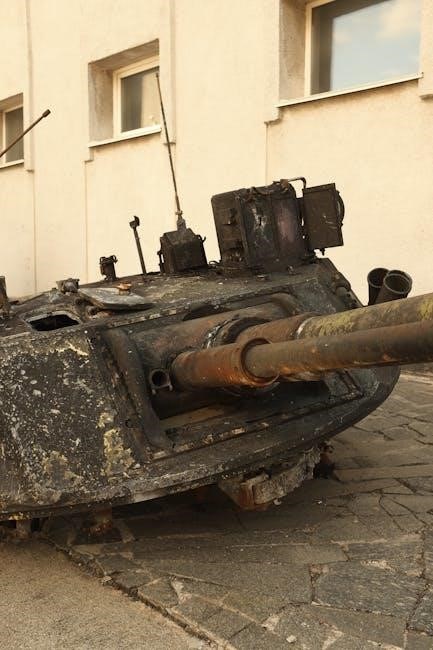Urban warfare presents unique challenges, requiring coordinated tank-infantry tactics. Tanks provide firepower but face vulnerabilities in dense environments, emphasizing the need for strategic deployment and combined arms operations.
1.1 The Evolution of Urban Warfare
Urban warfare has evolved significantly, from WWII’s city battles to modern conflicts in Ukraine. Historical cases like Hue City and Grozny highlight the growing complexity of urban combat, emphasizing the need for adapted tactics. The increasing density of urban populations and infrastructure has made cities central to modern warfare, requiring specialized strategies and combined arms operations to mitigate risks and achieve objectives effectively.
1.2 The Role of Tanks in Urban Combat
Tanks play a critical role in urban combat by providing mobile firepower and supporting infantry advances. Despite their vulnerabilities in dense environments, tanks are essential for breaching defenses and suppressing enemy positions. Their effectiveness relies on close coordination with infantry and engineering units, as well as strategic use of cover and obscurants to mitigate risks in urban terrain.
Fundamental Principles of Urban Tank Warfare
Urban tank warfare requires mastering narrow terrain, leveraging cover, and coordinating with infantry. Mobility and situational awareness are critical to mitigate vulnerabilities and achieve tactical superiority.
2.1 Challenges of Urban Terrain for Tanks
Urban environments pose significant challenges, including narrow streets, dense structures, and ambush risks. Tanks face limited visibility, constrained maneuverability, and increased vulnerability to anti-tank weapons. Additionally, civilians and infrastructure complicate operations, requiring precise tactics to minimize collateral damage while maintaining combat effectiveness in confined and unpredictable conditions.
2.2 Importance of Infantry-Tank Coordination
Effective infantry-tank coordination is crucial in urban warfare. Infantry provides close protection, identifies threats, and clears paths, while tanks offer suppressive fire and breach barriers. This synergy enhances survivability, allowing tanks to navigate safely and infantry to secure key positions, ensuring coordinated and decisive operations in densely populated and high-risk environments.
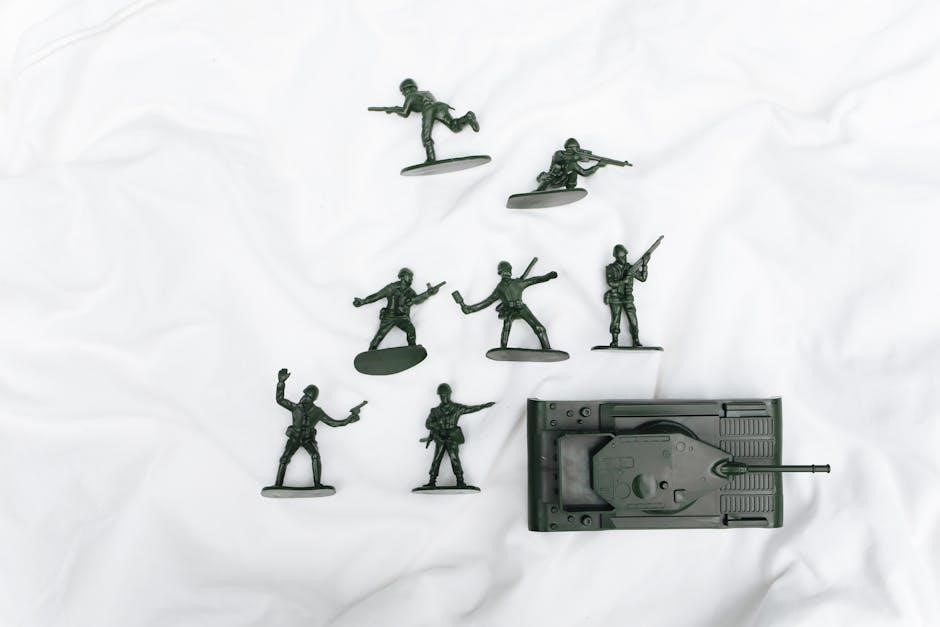
Historical Case Studies of Urban Tank Combat
Urban tank combat has been shaped by battles like Hue City, Mogadishu, and Grozny. These case studies reveal the challenges and effectiveness of tank operations in densely populated areas, offering insights into modern urban warfare strategies.
3.1 Hue City, Vietnam (1968)
The Battle of Hue City highlighted the challenges of urban tank warfare. U.S. Marines and tanks faced intense street fighting, with narrow streets limiting mobility. Tanks provided crucial fire support but were vulnerable to anti-tank weapons. The battle underscored the importance of infantry-tank coordination and adaptability in urban combat, shaping future tactics for armored units in densely populated areas.
3.2 Mogadishu, Somalia (1993)
The Battle of Mogadishu highlighted urban warfare challenges. U.S. forces faced fierce resistance, with tanks playing a limited role due to narrow streets and ambush threats. The operation underscored vulnerabilities in urban terrain, emphasizing the need for combined arms tactics and situational training to enhance survivability and effectiveness in densely populated, hostile environments.
3.3 Grozny, Chechnya (1994-1995)
The Battle of Grozny showcased the harsh realities of urban warfare. Russian tanks faced significant challenges due to narrow streets, ambushes, and heavy resistance. The urban terrain nullified many advantages of armored vehicles, highlighting the need for combined arms tactics and precise coordination with infantry. This conflict underscored the importance of situational training and adaptability in densely populated, hostile environments.
Mobility and Positioning in Urban Environments
Urban terrain restricts tank mobility, requiring precise positioning to navigate narrow streets and avoid bottlenecks. Effective maneuvering ensures optimal support for infantry while minimizing vulnerabilities to ambushes.
4.1 Navigating Narrow Streets and Alleyways
Navigating narrow urban streets and alleyways requires precise planning and situational awareness. Tanks must avoid bottlenecks and use reconnaissance to identify viable routes. Infantry support is crucial to clear paths and neutralize ambush points. Limited visibility and tight spaces demand slow, deliberate movement, ensuring tanks remain protected while maintaining offensive capabilities in constrained environments.
4.2 Utilizing Cover and Concealment
Urban terrain offers natural cover like buildings, rubble, and alleyways, which tanks can exploit to reduce vulnerability. Concealment is critical to avoid enemy targeting. Tanks should position behind structures to mask their profiles and minimize exposure. Utilizing smoke and obscurants can create temporary cover, enabling safe repositioning. Effective use of cover enhances survivability and maintains tactical advantage in dense urban environments.
4.3 Overcoming Urban Obstacles
Urban obstacles like rubble, craters, and destroyed vehicles impede tank mobility. Engineers play a key role in clearing paths and breaching walls. Tanks must navigate carefully to avoid immobilization. Utilizing specialized equipment, such as mine rollers, can help overcome hazards. Effective obstacle clearance ensures sustained movement and maintains the momentum of urban operations, preventing delays that expose tanks to enemy fire.
Firepower and Support Systems in Urban Warfare
Tanks deliver precise firepower in urban environments, supported by infantry and artillery. Smoke and obscurants enhance survivability, enabling effective engagement while minimizing collateral damage and civilian risk.
5.1 Effective Use of Tank Firepower
Tank firepower in urban warfare requires precision to target enemy strongpoints while minimizing collateral damage. High-explosive rounds are effective against fortified structures, while armor-piercing rounds engage enemy armor. Coordination with infantry ensures accurate targeting, reducing risks to civilians. Proper use of firepower enhances mission success and maintains operational momentum in densely populated areas.
5.2 Coordination with Supporting Infantry and Artillery
Effective coordination between tanks, infantry, and artillery is crucial in urban warfare. Tanks provide suppressive fire, while infantry clears buildings and identifies targets. Artillery supports with indirect fire, reducing collateral damage. Clear communication and synchronized movements ensure mission success, minimize friendly fire risks, and enhance overall combat effectiveness in complex urban environments.
5.3 Role of Smoke and Obscurants
Smoke and obscurants are vital in urban warfare, providing cover for tank maneuvers and infantry advances. They obscure enemy lines of sight, disrupt targeting systems, and create temporary barriers. This allows tanks to reposition safely and infantry to close gaps, enhancing tactical flexibility and survivability in densely populated and contested urban zones.
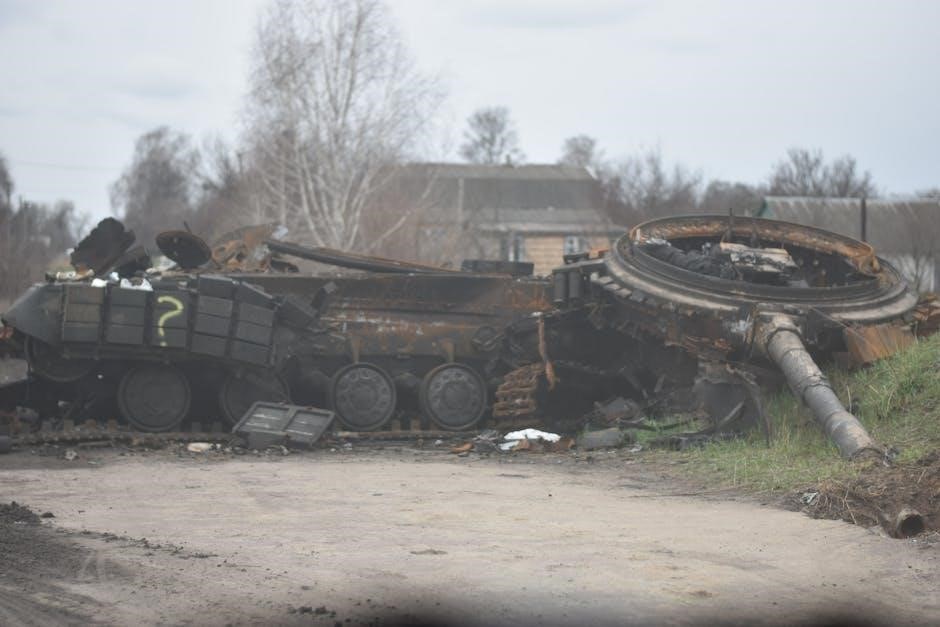
Combined Arms Operations in Urban Warfare
Combined arms operations in urban warfare integrate tanks, infantry, engineers, and artillery, ensuring coordinated efforts to enhance operational effectiveness in densely populated environments.
6.1 Integration of Tanks with Infantry Units
Effective integration of tanks with infantry is critical in urban warfare. Tanks provide suppressive fire and cover, while infantry clears buildings and neutralizes threats. This synergy enhances situational awareness, reduces vulnerabilities, and ensures mission success in densely populated and complex environments.
6;2 Role of Engineering Units in Urban Combat
Engineering units play a crucial role in urban combat, enabling tank and infantry operations by breaching obstacles, clearing routes, and demolishing structures. They also facilitate mission success by creating tactical advantages, ensuring mobility, and mitigating hazards like IEDs, thereby supporting combined arms operations effectively.
Psychological and Civilian Considerations
Urban warfare impacts civilians and soldiers mentally, requiring careful strategies to minimize collateral damage and maintain public support while addressing the psychological toll on combatants.
7.1 Psychological Impact of Tanks on Enemy Forces
Tanks in urban warfare exert significant psychological influence, intimidating enemy forces with their firepower and dominance. The presence of tanks can disrupt enemy morale, leading to retreats or reduced resistance. The sheer power of armored vehicles creates a perception of invincibility, further strategizing enemy tactics and decision-making under pressure.
7.2 Minimizing Civilian Casualties and Collateral Damage
Minimizing civilian casualties requires precise targeting and controlled firepower. Tanks must operate with caution, employing advanced optics and intel to distinguish combatants from non-combatants. Urban terrain complicates this, necessitating strict adherence to rules of engagement and coordination with infantry to ensure civilian safety while achieving tactical objectives.
Training and Doctrine for Urban Tank Warfare
Effective training emphasizes situational awareness, combined arms tactics, and adaptive doctrine. Crews must master urban terrain challenges, ensuring precise execution of maneuvers and tactical decisions under pressure.
8.1 Situational Training for Tank Crews
Situational training focuses on realistic urban scenarios, enhancing crew adaptability. Exercises simulate navigating narrow streets, utilizing cover, and coordinating with infantry. Emphasis is placed on quick decision-making and precision firepower. Training incorporates combined arms operations, ensuring seamless integration with other units. Practical drills address overcoming obstacles and mitigating vulnerabilities in dense environments, preparing crews for the complexities of modern urban warfare.
8.2 Doctrine and TTPs (Tactics, Techniques, and Procedures)
Doctrine and TTPs provide standardized guidelines for urban tank operations, emphasizing coordination with infantry and combined arms integration. Manuals outline principles for navigating urban terrain, leveraging cover, and executing precision firepower. Training focuses on understanding weapon effects, surface danger zones, and situational adaptability. These protocols ensure crews operate effectively in dynamic environments, aligning with broader military objectives and enhancing operational success in urban warfare.
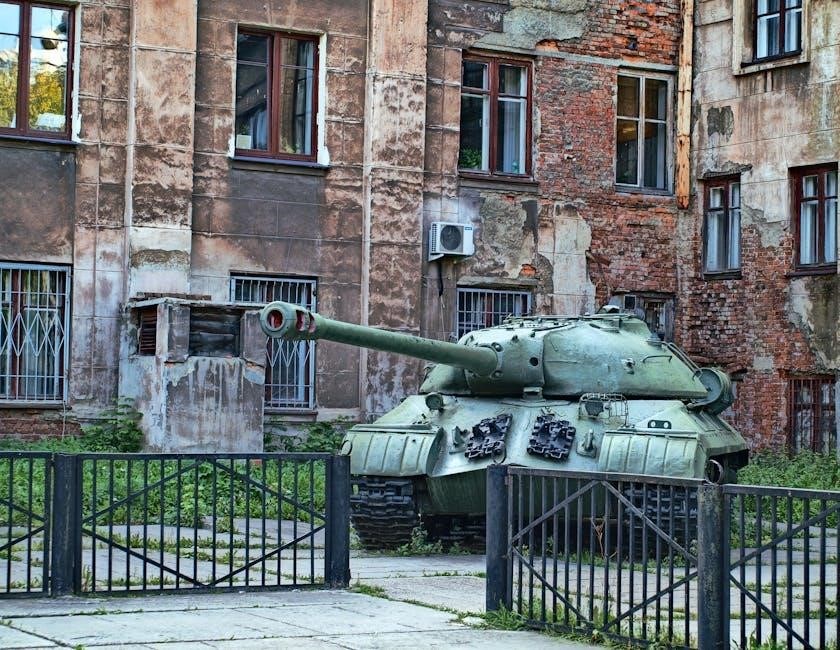
Future Trends in Urban Tank Warfare
Future trends include advanced tank designs with enhanced mobility and survivability, alongside evolving tactics to counter asymmetric threats in densely populated urban environments effectively.
9.1 Technological Advancements in Tank Design
Technological advancements in tank design are revolutionizing urban warfare capabilities. Modern tanks now feature active protection systems, modular armor, and next-gen fire control systems. AI-driven targeting enhances precision, while autonomous systems reduce crew vulnerability. These innovations improve mobility, survivability, and lethality in dense urban environments, ensuring tanks remain pivotal in future urban combat scenarios.
9.2 Adapting Tactics for Asymmetric Threats
Asymmetric threats demand adaptive tactics, integrating tanks with agile infantry and intelligence units. Urban warfare requires decentralized command structures and real-time information sharing. Tanks must operate in smaller, more maneuverable formations, leveraging cover and precision firepower. These strategies enhance flexibility and counter unconventional enemy tactics, ensuring effective urban combat operations against diverse and evolving threats.
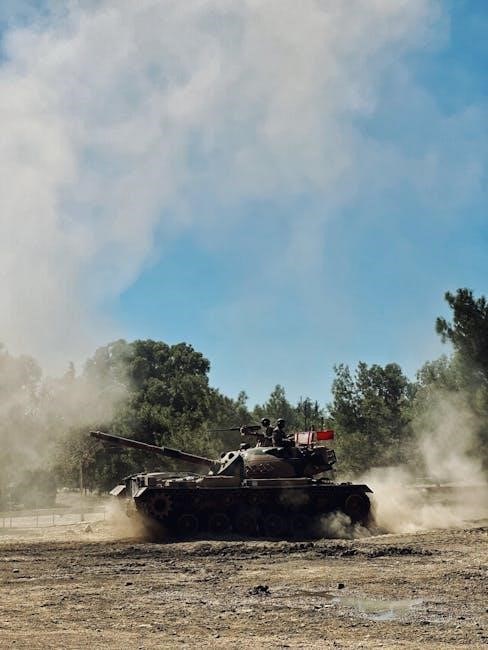
Resources and References
Comprehensive guides and PDFs on urban tank tactics are available online, offering insights into historical case studies, combined arms strategies, and modern technological advancements in armored warfare.
10.1 Recommended Reading and PDF Guides
Key resources include “Breaking the Mold: Tanks in the Cities” and “ArmouredWarfareTankTactics,” offering insights into urban tank tactics. Free PDF downloads are available for historical case studies like Hue City and Mogadishu, providing practical lessons. Additional guides cover combined arms operations and situational training, essential for modern urban warfare strategies and doctrine development.
10.2 Online Resources for Urban Warfare Tactics
Online platforms like ArmouredWarfareTankTactics and military forums offer comprehensive guides and case studies. Websites provide downloadable PDFs on urban tank tactics, including historical analyses and modern strategies. These resources emphasize combined arms operations, situational training, and doctrinal approaches, offering practical insights for military professionals and strategists focused on urban warfare scenarios.
Urban warfare remains a critical aspect of modern conflict. Tanks, despite vulnerabilities, play a vital role when coordinated with infantry. Future tactics must adapt to evolving threats and environments.
11.1 Summary of Key Takeaways
Urban warfare demands precise coordination between tanks and infantry, leveraging their strengths while mitigating vulnerabilities. Historical case studies highlight the importance of adaptive tactics, combined arms operations, and situational training. As urban environments evolve, future tank tactics must emphasize mobility, firepower, and psychological impact while addressing civilian safety and asymmetric threats.
11.2 The Future of Tank Tactics in Urban Warfare
The future of urban tank tactics lies in technological advancements, such as improved armor and precision firepower, enabling tanks to thrive in dense environments. Enhanced situational training and adaptive doctrines will be critical. Asymmetric threats demand innovative strategies, ensuring tanks remain effective while minimizing collateral damage and protecting civilians in increasingly complex urban conflict zones.
